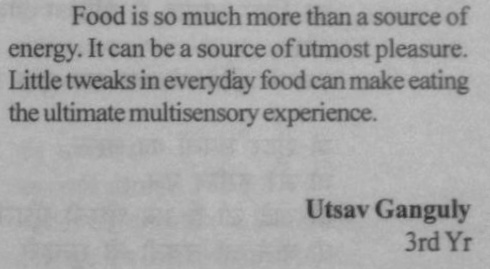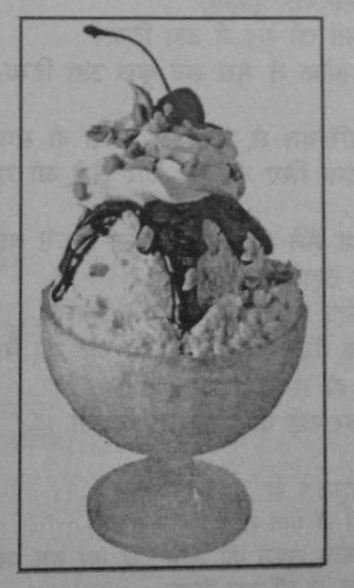Merry Christmas to all the readers of The Gourmet Glutton. As a Christmastime treat, I’ve decided to post the 2014 article I wrote for my college magazine Rupantar, the catalyst for my Food and the Senses series. Click here if you missed the first part. And here’s part 2 of the original FATS.

So, that’s the taste and smell sorted. True, they are the most important senses in our eating experience, but the other senses can very well be engaged. Like the eyes for example. Of course, it is said that we ‘eat with our eyes first’, the look of a dish makes it appetizing or unappetizing. The same food presented beautifully will have a better appeal than poorly served food, an idea giving birth to the concept of the French ‘nouveau cuisine’ in the 80s, with artistically decorated plated dishes.
But that is only a tiny part of the role our eyes play. Artistic and aesthetic appeal might control our decision about whether or not we want to try out the food, but the look can change our perception of the food altogether. An experiment was carried out. Four bowls of jelly were taken. To each bowl, different odourless, flavourless food colour was added, red, blue, yellow and green. Blindfolded, they all taste similar: a sweet with a hint of sour. Now, subjects were asked to taste them and identify the flavours in the jelly. Most subjects identified the red as sweet, like strawberries, the yellow as sour, like lemons, the green like a mix of sweet and sour, like green apples, and the blue seemed to taste weird.
Here’s another example: At the University of Bordeaux in France, 54 skilled wine students were asked to taste a red and a white wine and note their aromas. They described the two wines differently. However, the red wine wasn’t red at all, it was the same white wine with some flavorless coloring added to it, yet the tasters experienced the typically berry like characteristics of red wine. Indeed, you eat what you see. The eyes see the food and make an idea about its apparent taste. When there is a twist in the tale, it either goes unnoticed altogether or baffles the brain massively.
Of all colours, blue, especially dark blue is the most off putting of all when it comes to eating. Perhaps it comes from a correlation between the colour blue and poison. We’ve had lots of fruit candies in our childhood, red, yellow, orange, green, but rarely blue. Perhaps it has something to do with the fact that there are very few naturally blue foods (I am talking of indigo or crimson blue). Think of bluish moulds on stale bread, that’s not very appetizing. However, there are exceptions: the westerners eat a variety of striking looking purple potato and of course, blue cheeses, but I do not know how that will go down with us Indians.
Sound is also a vital component in our eating experience. On the simplest level, think of the crunch of a crispy batter over your “beguni”. The experience of the “sizzler” is all about the smoke and most importantly the sizzling sounds that the moist foods make on the hot plate. It is also believed that hearing the right sounds at the time of eating can enhance the flavour perception of food. Sounds of the seashore can apparently make fresh seafood taste better. Well, not much is known about that, but without sound, the food experience would lose a vital dimension.
Touch contributes to two other major backbones of food, texture and temperature. Let’s start with texture. It can grossly be described as the physical sensation of the food in the mouth. Bite into a fish butter fry and you get a crisp batter followed by a flaky fillet of fish. A classic French fry has a hard, crispy crust, and a soft potato center. Crushed almonds provide a crunch on top of a scoop of smooth ice cream. None of these descriptions have anything to do with flavor. Crispness, creaminess, flakiness and chewiness are all textural elements, which determine how the food “feels” in your mouth.
Texture is vital in any dish. Having one-dimensional texture is boring, just like having one-dimensional flavours. A simple plate of rice and dal lights up when some crispy “aloo bhaja” is added to the side, not because they taste great, but because they provide a so called “textural contrast” to the otherwise mushy rice and dal. A good dish must have a balance of textures.
After texture comes temperature. This is particularly important in two contexts……multi-course menus and desserts. In multi-course menus, it is common practice to start off with a room temperature salad and then move on to hotter elements like soups or starters. Rarely, however, do we see hot and cold elements on the same dish, except when it comes to desserts.
Temperature contrast is one of the pillars of dessert making. This contrast isn’t compulsory; we have a fair lot of hot desserts (hot Malpua or Soufflés) and cold desserts (ice creams and cheesecakes), but temperature contrast provides a whole new dimension altogether. An interesting “temperature contrast dessert” is the fried ice cream, with a hot crispy batter enclosing a cold icy centre.
Okay, we have come a long way. Let us now look at a simple dessert from this viewpoint: a scoop of vanilla ice cream with hot chocolate sauce with a piece of fresh strawberry, crushed almonds and a sprig of mint. The cold ice cream is balanced by the hot sauce, the creaminess and stickiness is balanced by the bite of the fruit and the crunch of the nuts, and it is a balance of sweet from the vanilla, sour from the berry and bitter from the sauce. Plus, the green mint adds to the looks of the dish.
Food is so much more than a source of energy. It can be a source of utmost pleasure. Little tweaks in everyday food can make eating the ultimate multisensory experience.

After that glimpse into the past, it is time to look ahead. The Gourmet Glutton has only just begun. We still have a long way to go, and a lot more to talk about. So, tune in for food science, dish reviews, historical anecdotes and a whole lot more.